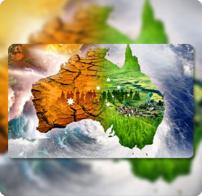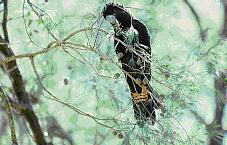
Logan and Albert Conservation Association

About one-fifth of Queensland's plant species can be found within the Scenic Rim Region. Six species guides are available to cover the former Beaudesert Shire area. Rainforests of the Scenic Rim are part of the Central Eastern Rainforest Reserves of Australia which is a World Heritage listed area, providing habitat for more than 200 rare or threatened plant and animal species including the Albert Lyrebird and spotted taile quoll. Biodiversity fact sheets or links are available here.
Two documents Climate Change Strategy 2008 and Climate Change Mitigation Action Plan are available for download and comment on council's website by 30 May 2008. To have your say an online feedback form is available.
The fate of the kangaroos on defence land in the ACT was discussed across the globe in newspapers and blogs. The volume of protests has presently stayed the cull and management of the confined native animals is still a challenge. The Australian Science Media Centre (AusSMC) publishes the thoughts of scientists on its Science Blog page. In the latest series of blogs, two scientists give their views about the vexed issue of the proposed kangaroo cull in the ACT.
Other documentation that can be considered is available from the RSPCA campaign website and their report known as the Kangaroo Shooting Code Compliance Report which is available online at www.environment.gov.au/biodiversity/trade-use/publications/kangaroo-report/index.html
Healthy Home is a unique online tool designed to help you reduce the environmental impact of your home, as well as offer information to assist you in protecting your house and family from from potential environmental hazards eg air pollution, toxic chemicals. In addition it also provide an online calculating tool to help you find out how much rainwater you can expect to harvest from your roof area. This website is provided collaboratively by Suncorp and Planet Ark.
Planet Ark runs a number of environmental campaigns and initiatives. Go to their website, click on any of the buttons to learn how to participate eg recycling, putting used printer cartridges into a ‘Cartridges 4 Planet Ark’ recycling box, recycling Aluminium Cans, and buying environmentally responsible products. You can even shop online.
FaunaNet is an online gateway to resources and expertise in biodiversity and conservation. The Australian Museum's Centre for Biodiversity and Conservation Research (CBCR) has coordinated the resources of FaunaNet into five modules.The site is here.
The Australian Museum has unique and extensive collections of natural science and cultural artefacts. The Museum's Centre for Biodiversity and Conservation Research (CBCR) is committed to the investigation and conservation of biodiversity. The internet provides a powerful means for the Centre to communicate its research results, and to provide both the scientific and broader communities with access to information on the biodiversity of NSW. To this end CBCR has developed a website dealing specifically with the Fauna of NSW - called FaunaNet. FaunaNet includes the following components:
FaunaNames
FaunaNames provides easy access to the New South Wales Master Names List (MNL). The MNL is a list of the valid scientific names of animals found in New South Wales. It is the ideal tool for taxonomists, systematists, biologists and ecologists to access knowledge of the scientific nomenclature and classification of the fauna of New South Wales. CANRI funding assisted in the development of this site.
FaunaMap
FaunaMap is the Australian Museum's online fauna mapping system. Through FaunaMap the user can: create maps showing the collecting location of specimens held in the Australian Museum fauna collection and obtain a list of the species held in the AM collections, from specific Local Government Areas, Bioregions, National Parks or Mapsheets.
Invertebrate Resources
A database of resources focused on the field of invertebrate research and discovery. The database includes websites, books, CD's, journals and online keys, as well as organisations devoted to invertebrate research and conservation.
FaunaKeys
This site provides access to a range of taxonomic keys for identifying selected invertebrate and vertebrate groups in New South Wales and Australia. The illustrated interactive keys combined with information pages and photo images of taxa provide hands-on education for both beginners and professionals in the field. CANRI funding assisted in the development of these keys.
Wildlife of Sydney
Wildlife of Sydney provides natural history information on a wide variety of animals that might be encountered in and around Sydney. The site allows Sydneysiders and visitors access to information about the great biodiversity that surrounds them. As well as about 400 species profiles the site describes the habitats where the animals and has a number of interactive features including games and a quiz which are based on aspects of the animal's biology or an ecological theme.
The Queensland Government has announced the TransLink Transit Authority will begin operation on 1 July 2008, and identifying what is important to customers and sourcing fresh ideas is a part of this process. By having your say online, you can help create a transit authority that will best meet the needs of South East Queensland. Closing date for submissions is 7 May 2008. To have your say online go to http://www.getinvolved.qld.gov.au/consultqld/
 GetUp is an independent, not-for-profit community campaigning group who uses new technology to empower Australians to have their say on important national issues. They receive no political party or government funding, and every campaign run is entirely supported by voluntary donations. If you'd like to contribute to help fund GetUp's work, you can donate online.
GetUp is an independent, not-for-profit community campaigning group who uses new technology to empower Australians to have their say on important national issues. They receive no political party or government funding, and every campaign run is entirely supported by voluntary donations. If you'd like to contribute to help fund GetUp's work, you can donate online.
Please go directly HERE for the latest campaign.
Click HERE to take you to the Climate Action campaign
The Spot the Difference ad campaign has been well supported by the Australian community.
LARGE BLACK PARASITES CRY OUT - TO BE SAVED!
By Andy Grodecki
This article was originally published in EcoInformationSource 2002
 |
Glossy Black Cockatoo |
All along the eastern seaboard of Australia a large black flying parasite can sometimes be heard crying out with deafening squawks reverberating around craggy cliffs. However, this magnificent creature is less commonly seen feeding on its helpless host. Not often referred to as a parasite, the Glossy Black Cockatoo (eastern subspecies) in South East Queensland must feed off either of two plant species to survive. A parasite is an organism that must feed exclusively off another organism to continue to exist.
The Glossy Black Cockatoo feeds for 6-7 hours a day exclusively on the very hard seeds of Sheoak trees. Surely they must feed on other stuff as well you ask? Well, it appears that the habit of the Glossy Black Cockatoo to chew bark, wood or fruits of gum trees (like other cockatoos) has been mistaken for feeding. All the studies to date show that it is just a thing they do and is not feeding. During the nesting season a division of labour agreement operates between the two partners. The female lays and incubates the eggs most of the time while the male partner feeds himself and then regurgitates food for the female. Good job they are close! Usually partners for life in fact. So the Glossy Black Cockatoo is effectively a mobile yet noisy parasite of the Sheoaks.